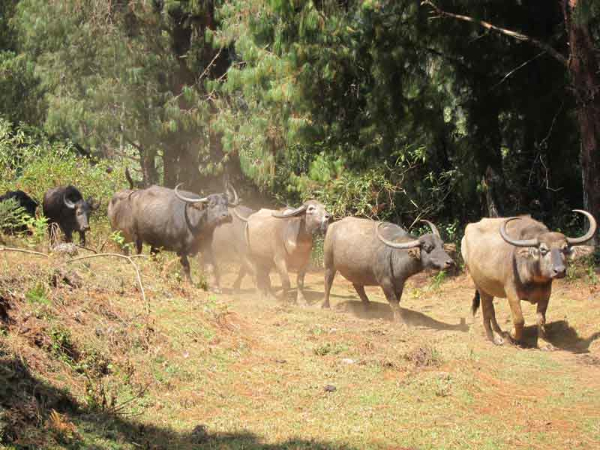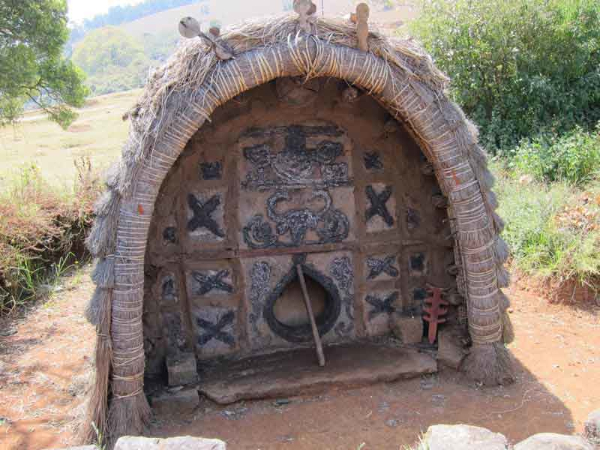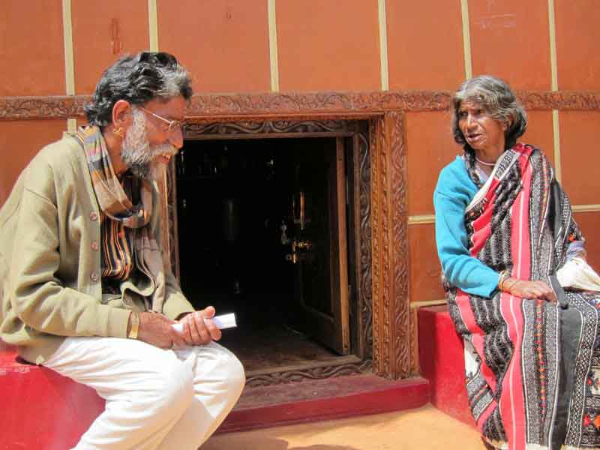
Photo © Ludwig Pesch
Learn more about the Toda community, their cultural traditions and the Nilgiri Biosphere >>
Until now, historians and anthropologists believed that Todas, a tribal group in the higher altitudes of the Nilgiris, reached there about 2,000 years ago. A new study by Indian Institute of Science, Bengaluru researchers shows the community was already settled there 3,500-4,000 years ago when a climate change occurred in southern India. […]
The buffalo-tending pastoral community is widely believed to be the earliest people to move into the upper Nilgiri plateau perhaps during the 1st century AD. It remained relatively isolated, until ‘discovered’ during the early 19th century by the erstwhile British administration. […]
Source: “Todas lived in Nilgiris 3,500 years ago” by P. Oppili (Times of India, 27 August 2020)
URL: https://timesofindia.indiatimes.com/articleshow/77771591.cms
Date visited: 29 November 2021
Todas of the Nilgiri Hills: Anthropological Reflections on Community Survival
By M.A. SiddiqueOf all the tribes of South India, the Todas of the Nilgiris remain as the most widely studied ethnic group till date, owing to its unique physical characteristics (such as tall stature, fair complexion, pointed and long nose), culture traits (such as half-barrel shaped huts, buffalo-centred culture, lacto-vegetarianism, weaving of embroidered shawl, the putkuli) and linguistic features (such as the phonetic correspondences of proto-Dravidian […], presence of residual suffixes and rich vocabulary of buffalo terms). Consequently, based on the above-cited unique characteristics, this tribal group has caused postulations of various hypotheses on their origin such as Scythian, Vedic Aryan, Israelite, Macedonian, which have been considered as mere fantastic suggestions and rejected by other schools of thought. […]
Although the Todas have been studied and documented both intensively and extensively by various scholars of India and abroad, the people of the Toda community still feel and express that both their culture and language have not yet been understood correctly and completely. […]
Source: Foreword by M.A. Siddique (Director of Museums, Chennai): Todas of the Nilgiri Hills: Anthropological Reflections on Community Survival by Jakka Parthasarathy (Director, Tribal Research Centre at M. Palada, Udhagamandalam), 2005
Tip: read or download the free searchable file (backup PDF, 1,5 MB) >>
Source: http://www.e-books-chennaimuseum.tn.gov.in/chennaimuseum/images/250/mobile/index.html#p=6
Date Visited: 15 December 2020
The Toda and Culture History: Some Reflections from a Dravidian Tribe of Nilgiri Hills
By Jakka Parthasarathy
Key Words: Cultural relativism, Tamil Language, Acculturation, Culture CoreCulture history is a perspective developed by anthropologists whose common concern is the inference of historical relationships from the observed spatial distribution of culture traits. Culture history continues to be an influential force in anthropology.
Each culture or each society in tribal communities possessed its own rationality and coherence in terms of which its customs and beliefs are to be interpreted. In India, the ethnographic world is in fact made up of communities and cultures in constant contact and change.
The paper seeks to examine the culture history and increasing rationality in the contemporary world among the Toda, a primitive tribal group inhabiting the Nilgiri District of Tamil Nadu State. The Toda people are living only on the upper plateau of the Nilgiri hills with an average elevation of 2300 ft. at the junction of the Eastern and the Western Ghats in Tamil Nadu State of India. The total Toda population as per 2001 census is 1560. It has been inferred that the Toda people are not aborigines, but came probably as conquerors or immigrants from the sea. The cultural relativism of the Todas with the hill habitat raised curious academic inquiry about ‘Who are the Todas?, How do they come to be living on the Nilgiri Hills?

Photo © Ludwig Pesch
Learn more about the Toda community, their cultural traditions and the Nilgiri Biosphere >>
The manuscript written by a Portuguese priest named Finicio in the year 1602, after his two day’s stay in the Nilgiri hills, is the earliest record on the Todas. From 1602 up to 1812 of the English occupation, we do not have the culture history of the Todas. Todas have received much attention mainly from their pastoral occupation of tending herds of buffaloes, living in half-barrel shaped huts, lacto-vegetarianism, fraternal polyandry, colour of the skin and unique physical features.
Todas today believe that they had always been on the Nilgiri hills. The ritual aspect of religion around sacred buffaloes and dairies, system of kinship, life cycle rituals connected with birth and death, dry funeral ceremony after nine months of cremation, priests who are bound to lead a life of celibacy with worldly thoughts, divination and magic, the custom of giving a cloth as the essential marriage ceremony etc., defend that Todas are a Dravidian tribe. Toda people speak a distinctive dialect which is not a blend of other languages. The Toda priests use sacred words during prayers. Earlier scholars, Bernhard Schmid, Caldwell, Pope and Rivers had accepted that Toda dialect is Dravidian and ascribed two-thirds of the Toda vocabulary to classical Tamil language. The paper also focuses attention on the possession of Toda rationality and coherence in understanding their own culture history. The paper concludes by arguing that the Toda customs and beliefs are in fact in constant contact and change but not going away form Dravidian philosophy. The study is based on field work conducted as a cultural anthropologist for the past two and half decades.
Source: http://www.thehindu.com/multimedia/archive/00151/WCTC_Souvenir_-_Par_151107a.pdf | Read or download this article in the backup file (PDF, 1,2 MB)
Date Visited: 16 April 2012
Abstracts for scholarly papers on a wide range of topics by experts on Tamil/Dravidian studies and its influence within and beyond India including music, folklore, linguistics, literature, ethnomusicology, intercultural and modern traits, archaeology, geography, ecology, botany, medicine, sociology, zoology, law, politics, and technology. | Find published papers by these and other scholars here >>
Contributors
Source: “WCTC Souvenir” (PDF 1,2 MB), courtesy The Hindu (Date Visited: 16 April 2012)
Aaron J. Paige, Ajmal Khan, P.M., Alexander M. Dubyanskiy, Amutha Pandian, Anaivaari R. Anandan, Andreas L. Katonis, Armstrong, S., Arogyaswami J. Paulraj, Arokianathan, S., Aruldoss Kanthiah, Aruna Devi, P., Arunachalam, A., Arunachalam, R., Arunan Sriskandarajah, Arunan, E., Asko Parpola, Ayothi, V., Bagavandas, M., Balaji, P.D., Balakrishnan, M., Balakrishnan, R., Balasubramanian, G., Beulah Jeyaseeli, S., Bhageerathi, M.A., Buck, David C., Chandrasekaran, A., Chelladurai Albert, Chelva Kanaganayakam, Chevillard, Jean-Luc, Chinnammai, S., Christhu Doss, M., Cristina Muru, Daniel Jeyaraj, Daniel, D., Dayalan, D., Deivanayagam, G., Devaraj Vijayakumar, Durga, S.A.K., Eva Wilden, Ganesan, N., Ganeshram, S., Ganga Ramachandran (Bageerathi), Geetha, N., George Joseph, S. V., Gnanam, M., Gnanasundaram, V., Gopalakrishnan Naduvattom, Govind Raj, Govindarajan, N., Gowri Diwaker, Gregory James, Gurumurthy, S., Hazeena Begum, V., Irai Anbu, Jacob Vetha Raj Y. Mohamed Sathik M. and Senthamarai Kannan, K., Jakka Parthasarathy, Jaya Venkatesh J., Jayabalan M., Jayanthasri Balakrishnan, Jayasitalakshmi, B.R., Jaroslav Vacek, Kalai Selvi, S., Kameswaran, S., Kannan, P.P., Kandaswamy, S.N., Kanthasamy Nallusamy, Karthikesu Sivathambi, Karthikeyan, S., Kasirajan, R., Kavitha Nakulan, Keeni Gita, A., Kiran Kesavamurthy, Komala Varadan, Kothandaraman, D., Kothandaraman, R., Krishnammal, S., Krishnamurthy, R., Krishanamurthi, R., Krishnaswami, P., Lakshman Singh, M., Lakshmi Ramaswamy, Logamanian, T., Maari Maurya, Madhavan, A.D., Madhivanan, R., Mahadevan Iravatham, Mahadevan Kathir, Mahalingam, K., Manavalan, A.A., Manickavasagam, M.E., Manikumar, K. A., Manju Nair, Manoharan, S., Manonmani Rathnavel, M., Marudanayagam, P., Maruthamalai Murugan, Matthew H. Baxter, Menon, A.G., Mikiko Kondo, Murthy, Y.Y.S.S.N., Murugaiyan, A., Murugaiyan Punal, K., Murugarathanam, T., Muthu Francis, S., Muthukumara Swamy, R., Muthupandian Ashokkumar, Nadaraja Pillai, N., Nagaswamy, R., Nageswara Rao, P., Naidu Pushpalatha, Narainsamy Tiroumalechetty, Narayanan Kannan, Natanasabapathy, S., Natarajan, S., Palaniappan Thiagarajan, Palanisamy Iyyana Devan, Pandian, P., Pandiyaraja, P., Pandurangan, Parthasarathi, K., Parthasarathy, G., Parthiban, M., Perialwar, R. & Gnanasundaram, V., Poongundran, R., Prabhakaran, B., Purushothaman, V.P., Rajendran, N., Ramachandran, G., Ramanathan, P., Ramanujam, Kallapiran, T., Ramasamy, A., Ramasamy, V., Ramaswami, N., Rangan, K., Ravi Subramaniam, Ravindranathan, S., Rose Mary, A., Sabarinathan, S., Sabharathnam, S.P., Sadasivam, M., Sampath Kumar, M., Sampath, M.D., Sanmugadas, A., Santhalingam, C., Saraspedee Tiroumalechetty, Saraswathi Venugopal, Saravanan Raja, Raghunatha Rao, B. Rajavel, S., Selvakumar, P., Selva Shunmugam, P. & Deiva Nayagam, C.N., Semmal Manavai Mustafa, Senarath Wikramasinghe, E.A., Seshadri, N., Sethuraman, M. & Rajan, S., Shan Shanmugam, P.E., Shunmugam, P., Shanmugam, S.V., Shanmugayogini Ravindran, Sherfraz, Simon Schmidt, Singaravelu Sachithanantham, Siva Pillai, Sivagowri Sivagurunathan, Sivathanu Pillai A., Smriti Haricharan, Soibam Rebika Devi, Solomon Raj, D., Solomon Selvam, Sridhar, T.S., Srinivasa Varma, G., Srinivasan, S., Sriskandarajah Sellathamby, Subrahmanyam, C., Subramani Kannupelli, Subramani Kannupelli, Subramanian, K.S., Subramanian, S.V., Sujatha Vijayaraghavan, Sukumar Rajagopal, Sunder Ganesan, G., Sundaresh, Gaur A. S, Vora K.H, and Sila Tripati, Suresh, V. & Nakkeeran, K.S., Swarna Sirisena, N. R., Tamil Selvi, Thajudeen, A.S., Thayyalnayaki, Thilakavathy, M., Thillainayagam, Thirumoorthy, G., Thiruvalluvan, V., Thomas Lehmann, Ulrike Niklas, Vanangamudi, P., Vasanthakumari, T., Veena Mushrif & Rajan, K., Veerapandian, S.A., Velmurugan, R., Velusamy, N., Venkatesan, P., Venkatesan, R., Vijaya Ramaswamy, Vijayalakshmi, V., Vijayaraghavan, R., Vijayaraghavan, R., Vijayavenugopal, G., Vinesh Yogindranathsingh Hookoomsing, Vridhachalem Subramaniam, Waradet Mesangrutdharakul, Will Sweetman

Photo © Ludwig Pesch
Learn more about the
Toda community, the Nilgiri Biosphere where the live, other elders,
the cultural identity communities have cherished for centuries, and this
in spite of the colonial legacy still affecting their members >>
Preserving our vanishing tribes, their heritage, language and wisdom
By Osama ManzarThe breathtaking Nilgiris are home to a number of indigenous tribes, one of which is Toda. Unfortunately, the once thriving tribe has fewer than 1,000 members today. Based on the yardstick set by our modern education system, these tribesmen and women are considered illiterate and backward. However, one has to visit their homes, interact with them and see their craft to truly understand the depth of their knowledge, art, traditions and sensibilities. The Toda tribe is largely dependent on buffalo herding and embroidery for its livelihood. Its members are incredibly skilled artisans known for the red-and-black embroidery on white fabrics that has even earned them a GI (geographical indication) tag. They live sustainable lives, in harmony with nature where all their resources are available. The Toda tribals have their own language, which does not have a script.
Over the last century, their numbers have been dwindling. The sharp decline in their population is largely related to the decline in agriculture land, much of which has been lost of afforestation. With their dwindling numbers, their art, craft and traditions are facing a slow death. If not preserved, the day is not far when their unique embroidery, for instance, is lost forever.
The Todas are an extremely closed community, barely connected to the rest of the world and, thus, deprived of the opportunities connectivity offers. They are not alone in leading marginalized and excluded lives. Overall, Scheduled Tribes account for 8.6% of India’s population, according to the 2011 Census. […]
Source: “Preserving our vanishing tribes, their heritage, language and wisdom” by Osama Manzar (Livemint, 8 September 2017)
URL: https://www.livemint.com/Opinion/AhrviHfdlAluJ6ffBBpUQN/Preserving-our-vanishing-tribes-their-heritage-language-an.html
Date visited: 29 November 2021
[Bold typeface added above for emphasis]
Up-to-date reports by Indian journalists and commentators
To search Indian periodicals, magazines, web portals and other sources safely, click here. To find an Indian PhD thesis on a particular tribal community, region and related issues, click here >>
Search tips
Combine the name of any particular state, language or region with that of any tribal (Adivasi) community.
Add keywords of special interest (music, poetry, dance just as health, sacred grove and biodiversity); learn about the rights of Scheduled Tribes such as the “Forest Rights Act” (FRA); and the United Nations “Declaration on the Rights of Indigenous Peoples”, “Universal Declaration of Human Rights”, “women’s rights”, or “children’s right to education”.
Specify any other issue or news item you want to learn more about (biodiversity, bonded labour and human trafficking, climate change, ecology, economic development, ethnobotany, ethnomedicine, global warming, hunter-gatherers in a particular region or state, prevention of rural poverty, water access).
For official figures include “scheduled tribe ST” along with a union state or region: e.g. “Chhattisgarh ST community”, “Himalayan tribe”, “Scheduled tribe Tamil Nadu census”, “ST Kerala census”, “Particularly Vulnerable Tribal Group Jharkhand”, “PVTG Rajasthan”, “Adivasi ST Kerala”, “Adibasi ST West Bengal” etc.
In case the Google Custom Search window is not displayed here try the following: (1) toggle between “Reader” and regular viewing; (2) in your browser’s Security settings select “Enable JavaScript” | More tips >>
Note: hyperlinks and quotes are meant for fact-checking and information purposes only | Disclaimer >>

See also
Adivasi Academy & Museum of Adivasi Voice at Tejgadh | Lecture “A View of Higher Education in India”
Appropriate education for Adivasi children – the Vidyodaya School model at Gudalur
Childhood | Children’s books | Childrens rights: UNICEF India | Safe search
People’s Linguistic Survey of India | Volumes (PLSI) | PeoplesLinguisticSurvey.org
Multi-lingual education | Residential school | Ekalavya
Multilingual education is a pillar of intergenerational learning – Unesco
Santali education | Teaching Santal children by Boro Baski
Unesco | Unicef | Unicef India | United Nations
United Nations International Days and Weeks
Video | “Nations don’t make us human – languages make us human”: Ganesh Devy
Women | Safe search | President Droupadi Murmu on women’s empowerment
Tip: click on any red marker for details on endangered languages in a particular region of India.
Please note: the facts and figures cited (via hyperlinks) links call for updates and fact checking >>
Cultural invisibility – India’s 600 potentially endangered languages | Linguistic Survey of India (official website) >>